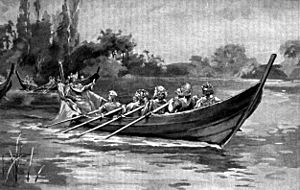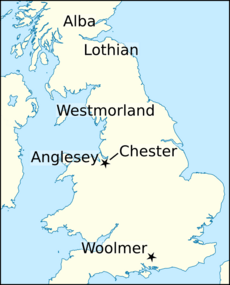Máel Coluim, King of Strathclyde facts for kids
Quick facts for kids Máel Coluim |
|
|---|---|

Máel Coluim's name and title as it appears on folio 5v of British Library Cotton Domitian A VIII (De primo Saxonum adventu): "Malcolm rex Cumbrorum".
|
|
| King of Strathclyde | |
| Predecessor | Dyfnwal ab Owain or Rhydderch ap Dyfnwal |
| Successor | Owain ap Dyfnwal |
| Died | 997 |
| Issue | Owain Foel? |
| Father | Dyfnwal ab Owain |
Máel Coluim (died 997) was a king of Strathclyde in the 900s. He was a younger son of Dyfnwal ab Owain, King of Strathclyde. His family had ruled the Kingdom of Strathclyde for many years. Máel Coluim's name is Gaelic. This might mean he was born when the Scots and Cumbrians were friends. Or it could show that the Scots had some control over the Cumbrians.
In 945, Edmund I, King of the English attacked Strathclyde. He seemed to let the Scots have power over the Cumbrians. Some stories say the English king harmed Máel Coluim's brothers. This might have been to stop Dyfnwal from having an heir. We don't know exactly when Dyfnwal stopped being king.
By 973, Máel Coluim was involved in ruling. He and his father met with Edgar, King of the English. This was a big meeting of kings. It might have been about keeping peace between England, Scotland, and Strathclyde. It could also have been about the danger from Vikings from Dublin and the Isles. Máel Coluim's father died in 975 while on a trip to Rome. Máel Coluim likely became king around this time. His rule wasn't very eventful. He was probably followed by his brother, Owain. Owain's successor, Owain Foel, might have been Máel Coluim's son.
Contents
Máel Coluim's Family and English Attacks
Máel Coluim was the son of Dyfnwal ab Owain, King of Strathclyde. Dyfnwal ruled the Cumbrian Kingdom of Strathclyde from about the 930s to the 970s. Máel Coluim's Gaelic name might show a link between his family and the Scottish royal family. It could also mean he was named after Máel Coluim mac Domnaill, King of Alba. This might suggest Dyfnwal had to accept the Scottish king's power.
In 945, English records say that Edmund I, King of the English attacked Strathclyde. He then gave control of the area to Máel Coluim mac Domnaill, the Scottish king. The Scottish king agreed to help Edmund by land and sea. Some old stories say Edmund harmed two of Dyfnwal's sons. If true, this could mean the princes were English hostages. Or they might have been captured during the fighting. Harming royal heirs was sometimes done to stop a king from having a successor.
This harsh act might mean Dyfnwal had broken promises to the English. Perhaps he was helping Scandinavian leaders. The English king might have used this attack to show his power to nearby rulers. Máel Coluim's Gaelic name could mean he was born when Scotland controlled Strathclyde. Or it could show a time when Scots and Cumbrians got along well.
Conflict with the Scots

After Illulb mac Custantín, King of Alba died in 962, Dub mac Maíl Choluim became the Scottish king. Then Illulb's son, Cuilén, took over. Cuilén's rule ended violently in 971. It seems a son of Dyfnwal killed him. The Chronicle of the Kings of Alba says Rhydderch ap Dyfnwal killed Cuilén because of his daughter. We don't know if Rhydderch was a king himself. But he must have been very important. His fighting group was strong enough to defeat Cuilén's.

Cuilén's relative, Cináed mac Maíl Choluim, became the next King of Alba. One of his first actions was to attack Strathclyde. This attack was probably revenge for Cuilén's death. It also showed Scottish power. But Cináed's invasion failed. This shows that the Cumbrian kingdom was strong. Dyfnwal might still have been king when Cuilén died. Or Máel Coluim might have become king around this time. Cináed built a fort near the River Forth, perhaps to stop Cumbrian attacks.
Máel Coluim and the Meeting of Kings

There is proof that Máel Coluim and his father were at a meeting in Chester in 973. This meeting was called by Edgar, King of the English. After Edgar became king, he gathered a large navy. He then met with six kings in Chester. Later stories said eight kings met him. They even claimed these kings rowed Edgar down the River Dee. This was to show they accepted his power.

The story of the kings rowing Edgar might not be true. But many of the named kings were real rulers. This suggests some kind of agreement happened. Later accounts say the kings submitted to Edgar. But older records just say they agreed to work together. This meeting might be linked to Edmund's attack on Cumbria in 945. Edmund had given Cumbria to the Scottish king on the condition they would "work together."
Some sources say Edgar gave Lothian to Cináed in 975. If this happened at the Chester meeting, it wasn't just about submission. It was more about cooperation along the English border. By 927, Strathclyde's southern border was near the River Eamont. So, Chester was a good place for everyone to meet.
Cináed, the Scottish king, was one of the kings at the meeting. If he was there, his rival, Amlaíb mac Illuilb, probably wasn't. The meeting might have been about the Scottish border. Other kings present might have been Maccus mac Arailt and his brother Gofraid. These two leaders from the Isles were seen as a threat. They had attacked Anglesey earlier. So, Edgar's meeting might have been to stop them. After the meeting, they might have turned their attention to Ireland instead.

The meeting also might have been about the growing power of Amlaíb Cúarán in Ireland. Edgar might have wanted to stop kings like Maccus and Gofraid from joining forces with him. He also wanted to prevent the Scots and Cumbrians from doing so. Another topic was likely the stability of the northern English border. For example, Thored Gunnerson attacked Westmorland in 966. This might have been a response to Cumbrian expansion southwards. Cináed's invasion of Cumbrian and English land might have been to fight Cumbrian power. Or it could have been to stop Thored from taking Cumbrian lands.
Máel Coluim's Rule and Death
Both Dyfnwal and Edgar died in 975. Dyfnwal died while on a religious journey. Records don't say much about Strathclyde between Dyfnwal's death in 975 and Máel Coluim's death in 997. It's not clear when Dyfnwal stopped being king. Rhydderch might have had power in 971. But Dyfnwal might still have been king in 973. Perhaps he gave power to Máel Coluim then. This could have been after Rhydderch killed Cuilén. Or Dyfnwal might have ruled until he left for his journey. If so, Edgar's death might have led to Dyfnwal's trip and Máel Coluim becoming king.
Máel Coluim's role at the meeting might have been about his father's journey. He might have wanted to ensure Dyfnwal's safe travel through Edgar's lands. If Máel Coluim was called a king at the meeting, it could mean Dyfnwal had already given him power. Or Máel Coluim might have just been representing his elderly father. He could have been acting as a temporary ruler. There's a record of a "Malcolm dux" who signed an English royal paper in 970. This might be Máel Coluim. If Máel Coluim was king in 973, Dyfnwal might have been an "elder statesman." He would have been an advisor with lots of experience.
If Máel Coluim became king after Dyfnwal, it means Rhydderch was either dead or couldn't rule. The sons of Dyfnwal who were harmed in 945 might have been alive. But their horrific injuries would have made them unfit to rule. Máel Coluim's reign was not very eventful. There are no records of fights between Scotland and Strathclyde when he became king. Dyfnwal leaving for Rome might mean he didn't think the kingdom was in danger.
Máel Coluim is mentioned in old poems from the 900s, like the Saltair na Rann. He died in 997, the same year as the Scottish king, Custantín mac Cuiléin, King of Alba. Máel Coluim's death is recorded in several Irish historical books. One calls him "king of the north Britons." His brother, Owain, seems to have taken over after him. Owain was then likely followed by Owain Foel, who might have been Máel Coluim's son.





